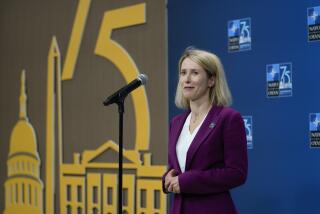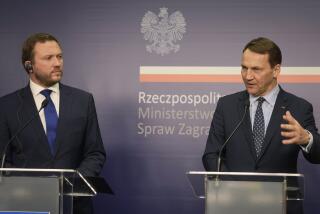Poised for Giddy Democratic Heights : Estonia: On the verge of free elections unsanctioned by Moscow, this Baltic state is fast making itself independent.
- Share via
Among the many odd happenings in Eastern Europe, the nearing elections of the Estonian Congress rank with the strangest. Here’s a country that Moscow still considers a part of the Soviet Union, yet its brash Citizens’ Committees are preparing for non-Soviet elections Saturday.
These will be full-fledged general elections that bypass the entire Soviet administrative structure and affirm the continued existence of the Republic of Estonia that Josef Stalin occupied and annexed 49 years ago. And Moscow, with 150,000 troops stationed in Estonia, has let these open preparations proceed unhindered. The goal of the Estonian Congress will be to start talks with Moscow for withdrawal of Soviet occupation forces.
The Citizens’ Committees were started a year ago by the Estonian Heritage Society, the National Independence Party and the Christian Union. The parties insisted that the committees be formed locally and not by emissaries from the capital. One is reminded of the “committees of correspondence” that prepared the ground for independence in the American colonies.
The Estonian committees spread their message person-to-person, circumventing an information blockade by the official Soviet media in Estonia. They weathered doubts and criticism by the much better-organized but more cautiously reformist Popular Front. The ruling Communist Party of Estonia first tried silence, then blistering attacks, but both failed. In November, the local committees formed a nationwide general committee led by Tunne Kelam, ideological leader of the Independence Party, with Heritage Society leader Trivimi Velliste as vice chairman.
By January the committees had registered more than half of the 1 million people who qualify as citizens of the Republic of Estonia. There are also half a million post-occupation settlers, mainly Russians, who are illegal immigrants in the eyes of the Republic of Estonia. The Citizens’ Committees are registering them, too, but only as applicants for citizenship, eligible to elect non-voting delegates to the Estonian Congress.
Prewar Russian residents of Estonia and their descendants qualify as citizens, while later immigrants do not, even if they are ethnically Estonian. Having left Estonia as a child in 1944, I qualified. When visiting Estonia in August, I registered at a booth set up in front of what used to be my kindergarten.
Setting up the practical machinery for nationwide elections is a demanding task even for a government. To do so while braving an administration in complete command of communication, transport and finances might look hopeless. Yet the structure is now in place. About 1,200 candidates are running for 464 seats in 110 multi-seat districts. Estonian exile organizations in the West will select 35 more delegates.
As election plans took shape, the previously hesitant popular mood shifted decisively, and the Popular Front jumped on the candidate bandwagon. The Communist Party of Estonia is considering doing the same, and several Soviet Estonian government leaders are poised to jump. Soviet Estonia’s head of state, Arnold Ruutel, has declared that “the Estonian Congress is a fact of political life” and represents a “unique citizens’ initiative reflecting the will of the Estonian people.”
Elections for the Estonian Supreme Soviet are scheduled for March 18. This new Supreme Soviet may never come to be, once the Estonian Congress is in place, but if it materializes, it will also be independence-minded. That leaves Moscow with two options (apart from a disastrous military suppression): agree that the Republic of Estonia is occupied territory from which Soviet troops should be withdrawn, or face a declaration of secession by “Soviet Estonia” (which would set a precedent for all other Soviet republics). It will be in Moscow’s interest to deal with the Estonian Congress, blaming Stalin for the occupation and illegal annexation.
The groundwork for such an approach was laid when the Moscow Supreme Soviet voided the Hitler-Stalin pact that, among other things, gave Estonia to Stalin. Mikhail Gorbachev may even have already decided to let the Baltic states go, which would explain why he has not acted against Estonia’s do-it-yourself elections.
More to Read
Sign up for Essential California
The most important California stories and recommendations in your inbox every morning.
You may occasionally receive promotional content from the Los Angeles Times.










